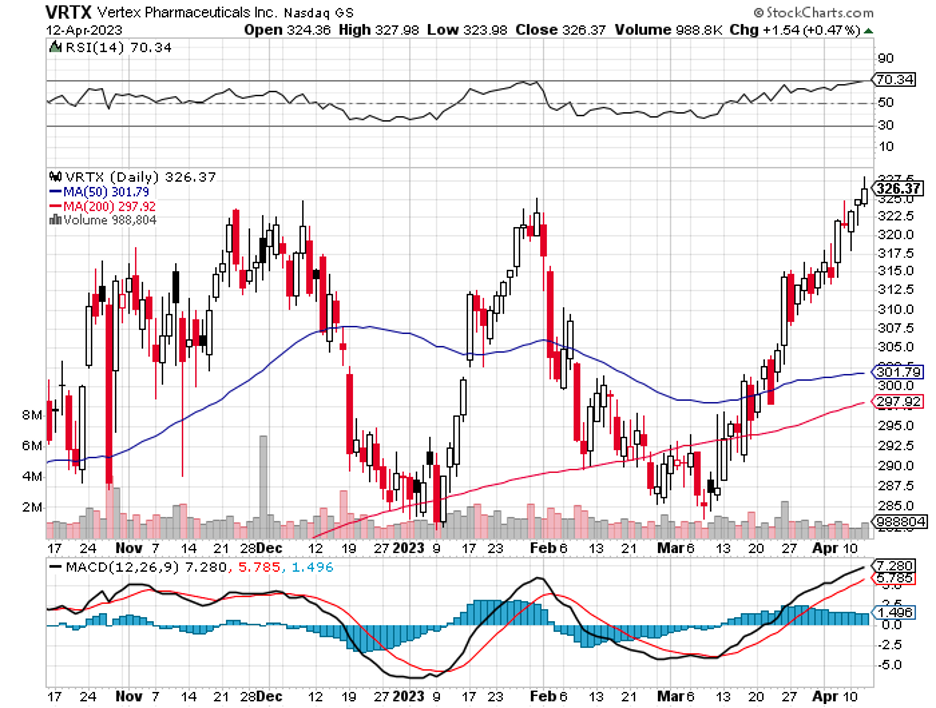When the Nasdaq Composite fell by 33%, it created the ideal excuse for savvy investors to pounce on high-quality discounted stocks.
While it can be one of the most uncomfortable learning experiences, Wall Street reminded investors last year that even the most promising stocks can and will plunge into unimaginable depths as quickly as they can skyrocket.
However, here’s a fascinating thing about the slipping prices courtesy of the bear market: These present a rare red-carpet chance for long-term investors. Although the Nasdaq Composite has been experiencing back-to-back double-digit corrections, a bull market almost always recoups its losses eventually.
Vertex Pharmaceuticals (VRTX) stands out as one of the most exciting growth stocks that investors should consider in the biotechnology and healthcare sector.
For the uninitiated, Vertex has become synonymous with cystic fibrosis (CF) treatments.
CF is a genetic disorder that affects the respiratory, digestive, and reproductive systems. It causes the production of thick and sticky mucus in these organs, leading to serious health problems. The global market for cystic fibrosis treatments is projected to reach $18.9 billion by 2027.
Vertex currently holds six approved CF treatments. Among these, the combination therapy Trikafta, also known as Kaftrio in the EU, stands out as their top-selling product. In 2022, Trikafta's sales surged to $7.6 billion from $3.8 billion in 2020, driving revenue growth.
Given its dominance in the market, it’s clear that no other drugmaker comes even close to challenging Vertex when it comes to CF. To boot, this biotech leader has several new areas of focus that hold the potential of not only delivering fresh revenue streams but also turning into blockbusters soon.
Actually, Vertex is a step closer to launching a new blockbuster in the form of a new type of treatment called exa-cel, which uses gene-editing technology to fix the genetic defect that leads to rare and often untreatable diseases.
The biotech and its co-developer, CRISPR Therapeutics (CRSP), recently submitted their application to the FDA to approve their sickle cell disease and beta-thalassemia treatments. The two companies are also waiting for approvals from the EU.
Based on the prevalence of these genetic blood disorders, the lack of effective treatments, and the potential of Vertex and CRISPR’s candidates to provide a one-time cure, the market size for exa-cel treatments for beta-thalassemia and sickle cell disease is estimated to be worth a total of $3.5 billion annually.
But, Vertex appears to have more plans for exa-cel.
For context, here is how exa-cel is applied to treatments for sickle cell disease and beta-thalassemia: the patient's own stem cells are collected and edited using CRISPR/Cas9 technology, creating exa-cel cells. These cells are then infused back into the patient after a conditioning process, which is currently done through chemotherapy with the drug Busulfan.
However, this approach is risky and has caused adverse effects in clinical trials. As a result, some patients with these conditions may not be able to benefit from exa-cel.
This concern prompted Vertex to explore new conditioning agents for exa-cel treatments that may be less aggressive on the body. They have licensed ImmunoGen's (IMGN) antibody-drug conjugate (ADC) technology, which is commonly used in cancer treatments to deliver cancer-killing agents directly to cancer cells without harming other cells.
ADCs are often used in cancer treatments to target cancer cells, specifically, sparing healthy cells from damage. This technology can potentially make the exa-cel treatment safer and more accessible for patients.
Regarding competitors, the frontrunner would be Bluebird Bio (BLUE). This was the first biotech to submit a sickle cell disease treatment candidate to the FDA. Unfortunately, its approval has faced delays. Still, Bluebird remains the only biotech that could be considered a direct rival of Vertex and CRISPR.
Apart from these, Vertex has two additional pipeline programs queued for launch by 2024.
The biotech expects to finalize its late-stage clinical trials for VX-548, a non-opioid pain treatment, by the first quarter of 2024. Vertex is also assessing a triple-drug combo targeting CF. Both candidates hold the promise of delivering over $2 billion in sales annually.
In addition, Vertex has been aggressive in acquiring companies to expand its portfolio.
Just last year, the biotech signified its plan to become an active player in the diabetes space when it bought ViaCyte and Catalyst Bioscience. Based on the portfolio of the acquired companies, Vertex appears to be making headway in developing stem cell treatments for Type 1 diabetes.
What do these developments mean? Well, it’s critical to review the whole picture.
Vertex already rakes in billions of dollars from its CF treatment franchise, and it’s highly plausible that the biotech will sustain its monopoly of the market for years to come.
At the same time, the company is also aggressively widening its reach and expanding into more lucrative segments. In short, the company is clearly on a roll. Given its track record and steady progress, it is an excellent long-term stock. I suggest you buy the dip.



